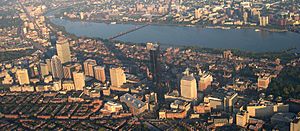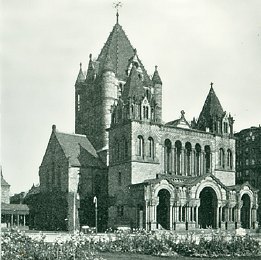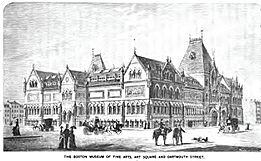Back Bay, Boston facts for kids
Quick facts for kids |
|
|
Back Bay Historic District
|
|
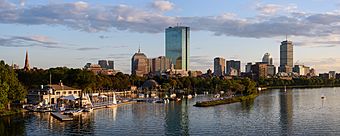
Back Bay and the Charles River
|
|
| Lua error in Module:Location_map at line 420: attempt to index field 'wikibase' (a nil value). | |
| Location | Boston, Massachusetts, U.S. |
|---|---|
| Architect | Multiple |
| Architectural style | Mid 19th Century Revival, Late 19th And 20th Century Revivals, Late Victorian |
| NRHP reference No. | 73001948 |
| Added to NRHP | August 14, 1973 |
Back Bay is a famous neighborhood in Boston, Massachusetts. It's special because it was built on land that used to be water! This area was once part of the Charles River basin.
Building started in 1859. People needed more fancy homes in the city. By about 1900, the whole area was filled in. Back Bay is known for its beautiful rows of Victorian brownstone houses. They are some of the best examples of 19th-century city design in the United States.
You can also find important buildings and cultural spots here. These include the Boston Public Library and the Boston Architectural College. At first, Back Bay was only for homes. But after 1890, businesses were allowed. Now, it has many office buildings, like the tall John Hancock Tower. It's also a great place for shopping, especially on Newbury and Boylston Streets. You'll find big malls like the Prudential Center and Copley Place here too.
The neighborhood's borders are the Charles River to the north. Arlington Street and Park Square are to the east. Columbus Avenue, Huntington Avenue, Dalton Street, and the Massachusetts Turnpike are to the south. Charlesgate East is the western border.
Contents
Back Bay: A City Built on Water
How Back Bay Was Created
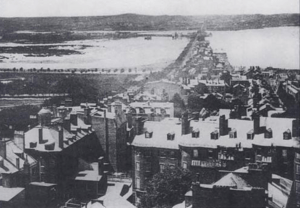
Before it became land, Back Bay was a real bay. It was west of the Shawmut Peninsula, between Boston and Cambridge. The Charles River flowed into it. This bay had tides, so the water went up and down every day. At low tide, much of the bay became a muddy marsh.
Long ago, about 5,200 years ago, Native Americans built fish weirs here. These were traps to catch fish. We know this because evidence was found during subway building in 1913. You can learn more about this at the Ancient Fishweir Project.
In 1814, a company tried to build a milldam here. This dam was also a toll road connecting Boston to Watertown. But the dam stopped the tides from washing away sewage. This caused bad smells and health problems. The project didn't work well and lost money. So, in 1857, a huge project began to "make land" by filling the bay.
Filling the Bay with Land
The company Goss and Munson built railroad lines to quarries in Needham, Massachusetts, about 9 miles (14 km) away. Trains with 35 cars full of gravel and other fill arrived every 45 minutes, day and night! When Needham ran out of gravel, more was brought from other towns.
The main part of Back Bay was filled by 1882. The project reached what is now Kenmore Square by 1890. It finally finished in the Fens around 1900. Much of the old mill dam is still buried under today's Beacon Street. This project was one of many that more than doubled the size of Boston's original land since 1820.
In 1910, the Charles River Dam was completed. This turned the salty river mouth into a freshwater basin. The Charles River Esplanade was then built. It gave people a nice place to enjoy the view of the new lagoon.
Getting Around Back Bay
Back Bay has five main streets that run east to west. These are Beacon Street, Marlborough Street, Commonwealth Avenue, Newbury Street and Boylston Street. These streets are crossed by north-south streets that are named in alphabetical order: Arlington, Berkeley, Clarendon, Dartmouth, Exeter, Fairfield, Gloucester, and Hereford Streets. All the east-west streets, except Commonwealth Avenue, are one-way streets.
In the 1960s, a plan called the "High Spine" helped build tall buildings. These skyscrapers were built along the Massachusetts Turnpike. This allowed for many big projects in the area.
Amazing Buildings and Design
Building Rules and Style
The design of Back Bay was planned by Arthur Gilman. It was inspired by the wide, tree-lined streets of Paris. Back Bay has wide, straight, tree-lined avenues. This was very different from other Boston neighborhoods.
The streets are Beacon Street (closest to the Charles River), Marlborough Street, Commonwealth Avenue (which has two one-way roads and a tree-lined park in the middle), Newbury Street and Boylston Street. These are crossed by streets named in alphabetical order: Arlington, Berkeley, Clarendon, Dartmouth, Exeter, Fairfield, Gloucester, and Hereford.
Rules about how far buildings had to be set back from the street were part of the land deeds. These rules created beautiful rows of three- to five-story brownstone homes. Most buildings on Newbury Street are now shops or mixed-use. Back Bay is listed on the National Register of Historic Places. It's seen as one of the best examples of 19th-century city architecture in the United States. In 1966, a special district was created to protect Back Bay's buildings. It makes sure changes to the outside of buildings fit the area's style.
Since the 1960s, the "High Spine" idea has guided building tall projects in Boston. This allows skyscrapers to be built along the Massachusetts Turnpike.
Famous Buildings in Copley Square
Copley Square is a central spot in Back Bay. It has many famous buildings.

- Trinity Church (built 1872–1877) was designed by H.H. Richardson. Many people think it's one of the most beautiful buildings in America.
- The first big building in Copley Square was the original Museum of Fine Arts. It opened in 1876. When the museum moved in 1909, its old building was taken down. The the Fairmont Copley Plaza Hotel was built there in 1912.
- The Boston Public Library (built 1888–1892) is a great example of Beaux-Arts architecture. It was meant to be "a palace for the people." In 1893, it had 600,000 books. This made it the largest free public library in the world.
- The Old South Church (built 1872–75) is across from the Boston Public Library. It was designed in the Venetian Gothic style. This style was inspired by the writer John Ruskin.
- There have been three "Hancock buildings" in Back Bay. The tallest is a skyscraper next to Trinity Church:
- The John Hancock Tower (built 1972) is New England's tallest building. It has 60 stories and is made of dark-blue reflective glass. It's a very striking building.
Other Important Back Bay Buildings
- The 52-story Prudential Tower (built 1964) was once considered amazing. The whole Prudential Center won an award in 2006 for being a great mixed-use property.
- 111 Huntington Avenue (built 2002) is a 36-story tower. It's Boston's eighth-tallest building. It has a cool open dome at the top and a beautiful garden.
- Arlington Street Church (Arthur Gilman, 1861) was the first church built in the new Back Bay. Its design was inspired by a church in London.
- Berkeley Building (1905) has a white terra cotta front and a steel frame.
- Boston Park Plaza (1927) was a very grand hotel. It was the first hotel in the world to have a radio in every room!
- Church of the Covenant (1865–1867) is a Presbyterian church. It was designed to be a tall Gothic building that no ordinary house could top.
- The First Church of Christ, Scientist (1894; extended 1904) is the main building of the Christian Science Plaza. This plaza also has a reflecting pool.
- The Gibson House (1860) is now a museum. It looks much like it did in the 1800s.
- The Mary Baker Eddy Library and Mapparium are a museum and library.
- The Saint Clement Eucharistic Shrine (1922) is now a Catholic church. It was first built for a different religious group.
Fun Places to Learn and Explore
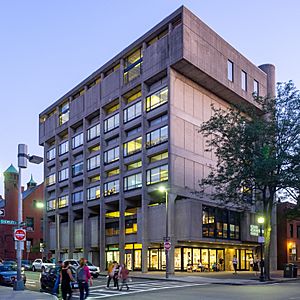
Back Bay has many important cultural and educational places:
- Alliance française, which teaches French language and culture.
- Berklee College of Music, a famous music school.
- Boston Architectural College, the oldest independent architecture school in the United States.
- Boston Conservatory, a school for music, dance, and theater.
- Goethe Institute, which promotes German language and culture.
- New England College of Optometry, the oldest school for eye care in the United States.
- New England Conservatory, another well-known music school.
- New England Historic Genealogical Society, a place to research family history.
Green Spaces and Parks
Back Bay has several beautiful parks and green areas:
- The Back Bay Fens is a large, pretty park on the south side of Back Bay. It's part of Boston's "Emerald Necklace" of parks.
- The Charles River Reservation runs along the Charles River on Back Bay's northern edge. It's a great place for walks and views.
- Commonwealth Avenue has a large, tree-lined park area in its center.
- Copley Square is a public square in southeast Back Bay. It's named after the famous painter John Singleton Copley.
Getting Around Back Bay: Transportation
Back Bay is easy to get to using public transportation. The Green Line subway has stations at Arlington, Copley, Hynes Convention Center, and Prudential. The Orange Line stops at Back Bay station. This station is also a stop for MBTA Commuter Rail and Amtrak trains.



